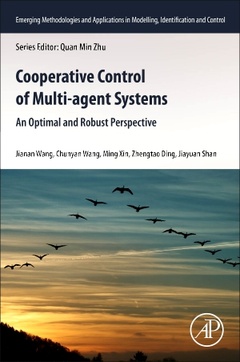Description
Cooperative Control of Multi-Agent Systems
An Optimal and Robust Perspective
Emerging Methodologies and Applications in Modelling, Identification and Control Series
Authors: Wang Jianan, Wang Chunyan, Xin Ming, Ding Zhengtao, Shan Jiayuan
Language: English
Subjects for Cooperative Control of Multi-Agent Systems:
174.92 €
In Print (Delivery period: 14 days).
Add to cart258 p. · 15x22.8 cm · Paperback
Description
/li>Contents
/li>Readership
/li>Biography
/li>Comment
/li>
Cooperative Control of Multi-Agent Systems: An Optimal and Robust Perspective reports and encourages technology transfer in the field of cooperative control of multi-agent systems. The book deals with UGVs, UAVs, UUVs and spacecraft, and more. It presents an extended exposition of the authors? recent work on all aspects of multi-agent technology. Modelling and cooperative control of multi-agent systems are topics of great interest, across both academia (research and education) and industry (for real applications and end-users). Graduate students and researchers from a wide spectrum of specialties in electrical, mechanical or aerospace engineering fields will use this book as a key resource.
Part One - About Cooperative Control 1. Introduction 2. Preliminaries
Part Two - Optimal Cooperative Control 3. Optimal consensus control of multiple integrator systems 4. Optimal cooperative tracking and flocking of multi-agent systems 5. Optimal formation control of multiple UAVs 6. Optimal coverage control of multi-robot systems
Part Three - Robust Cooperative Control 7. Robust consensus control of multi-agent systems with input delay 8. Robust consensus control of multi-agent systems with disturbance rejection 9. Robust consensus control nonlinear p-order integrator systems 10. Robust cooperative control of networked negative-imaginary systems
Researchers, graduate students, engineers and practitioners in Electrical, Mechanical, and Aerospace Engineering; experts and industrial control engineers
Chunyan Wang received the B.Eng. degree in automatic control from Dezhou University, Shandong, China, in 2006, the M.S. degree in control theory and control engineering from Soochow University, Jiangsu, China, in 2009, the M.Sc. degree in electrical and electronic engineering from the University of Greenwich, London, U.K., in 2012, and the Ph.D. degree in control systems from the University of Manchester, Manchester, U.K., in 2016. He is currently a Research Associate with the School of Electrical and Electronic Engineering, University of Manchester. His current research interests include cooperative control, robotics, and time-delay systems.
Ming Xin (SM’10) received the B.S. and M.S. degrees from the Nanjing University of Aeronautics and Astronautics, Nanjing, China, in 1993 and 1996, respectively, both in automatic control, and the Ph.D. degree in aerospace engineering from the Missouri University of Science and Technology, Rolla, MO, USA, in 2002. He is an Associate Professor with the Department of Mechanical and Aerospace Engineering, University of Missouri-Columbia, Columbia, MO. He has authored and coauthored more than 120 technical papers in his research areas. His research interests include optimization theory and applications, estimation/filtering and signal processing, and control o
- Helps shape the reader's understanding of optimal and robust cooperative control design techniques for multi-agent systems
- Presents new theoretical control challenges and investigates unresolved/open problems
- Explores future research trends in multi-agent systems
- Offers a certain amount of analytical mathematics, practical numerical procedures, and actual implementations of some proposed approaches




